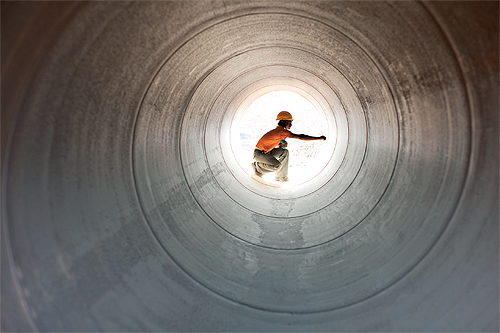Pushing boundaries
Four construction trends we’ll see in 2021 for a more resilient industry. By Allison Scott
We’ve seen dramatic changes in the construction industry over the last year. Although the challenges are immense, the evolution is incredible. In 2020, we saw a renaissance of new workflows, partnerships and mindsets – all making the industry stronger together.
Still, we have a long road ahead.
According to FMI, construction traditionally lags 12 to 18 months behind general recessions. ‘Resiliency’ will be an operative word for the industry to continue moving and excelling in the year ahead and beyond. The year 2021 has the potential to be transformative for the industry – but only if firms and workers continue to build their resiliency muscles to future-proof their businesses and strengthen the industry overall.
Here are four leading trends that will drive industry-wide resiliency in the years ahead:
Rising investment in sustainability
First, there will be a renewed focus on environmental resiliency, focusing on how energy sources, infrastructure and the built environment play a part in combating climate change. There is now well-documented evidence of how communities across the globe are being impacted by environmental events, the need for reliable energy sources and more. Being creative in our approach to these challenges is an AEC industry call-to-action. Firms that are already exploring next-generation net-zero construction, creative material use/re-use, intelligent infrastructure projects and renewable energy projects will be well-positioned to take advantage of the rise of ‘resilient’ projects that encourage sustainability.
Similarly, digital infrastructure projects like data centers are also poised to grow as the rise of digitization has accelerated due to remote working brought on by the pandemic. Since mission critical facilities use tremendous amounts of  energy, more and more digital infrastructure projects will seek to lower their environmental footprint by improving their facilities with heating/cooling efficiency, as well as exploring renewable energy sources.
energy, more and more digital infrastructure projects will seek to lower their environmental footprint by improving their facilities with heating/cooling efficiency, as well as exploring renewable energy sources.
Driving innovation with culture
Second, construction firms will continue to increase their focus on building a resilient workforce. As the pandemic showed, firms that readied teams with connected technology, remote working solutions and cultivated a culture of empathy, trust and flexibility have been able to weather the ups and downs of the last year. However, this roller coaster ride also stretched teams to their limits. We’ve all been dealing with the blurred lines of home and work life. The ability to adjust strategy and process has been impressive, but culture ultimately trumps strategy in the long term.
I’m optimistic that leading construction firms will take the challenges of the last year as an opportunity to revisit a number of their human resources and culture initiatives such as improving training of construction technology to include a broader set of roles both on and off the site; widening the talent pool by developing new roles for digital natives and a more diverse population; developing unique and fast-growth career paths that encourage folks to stay in the industry; increasing health and wellness benefits to include things like mental health, stress management and family-friendly care options; and increasing employee engagement tactics to improve a sense of community and build a culture of trust among distributed teams.
Reinventing business models
Third, many leading construction firms have taken on new technology over the last few years and increased their attention towards things like digitization as central to their work. However, most construction firms’ business models have not provided the right amount of resources and flexibility to support true innovation that will create exponential growth. Simply adding new tools to the stack doesn’t solve the root challenge of stagnant or out-of-date workflows, nor does it create lasting differentiation.
As construction firms take on the challenge of future proofing beyond 2021, leaders have an opportunity to drive an innovation mindset and rethink their technology investment and adoption strategy. Examples may include formalizing an internal cross-functional innovation council within their companies that are also responsible for change management and program management; exploring innovation R&D tax incentives; and applying a culture-driven approach to technology adoption that balances performance incentives with behavior change.
Reimagining technology & data
Over the last few years, many leading construction firms have taken on new technology and increased their attention towards digitization as being central to their work. Covid-19 has only accelerated the use of technology and digital workflows in the industry. For 2021 and beyond, this opens the doors to even more opportunities for businesses to reimagine how they utilize technology and data to build resiliency, including virtual collaboration, AI and machine learning.
Businesses have more data than ever before; we will see a significant increase in firms taking advantage of this new information and creating more core competencies around data, analytics and business intelligence. Examples include standardizing and formalizing data plans and strategies company-wide, expanding the use of connected and integrated technology solutions to reduce data silos and disconnects, and the growing utilization of dashboarding and analytics tools to inform project and business-level decisions.
We are at an important and exciting liminal moment for construction – a sea change, if you will – that is poised to unlock increased resiliency for people, process and technology. While we don’t know exactly what 2021 will bring, we do know that our industry’s advancement hinges on our ability to successfully reinvent, adapt and push boundaries.
Allison Scott is Director, Construction Thought Leadership & Customer Marketing at Autodesk. Autodesk Construction Cloud is a powerful portfolio of construction management software that combines advanced technology, a unique builders network and predictive insights to connect people and data across the entire building lifecycle, from design through to operations.
construction.autodesk.com